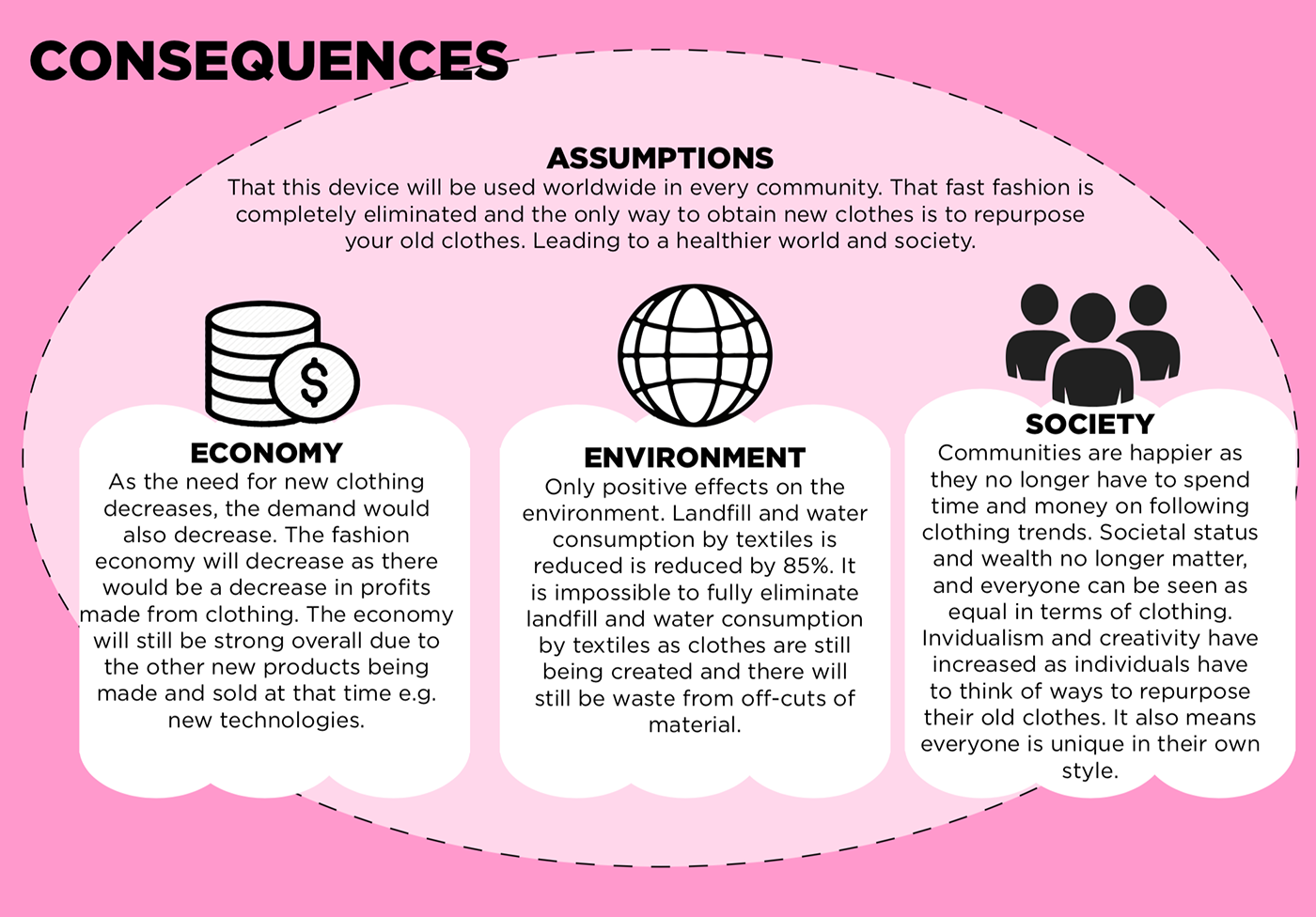

















REITERATING MY POINTS
CONTEXT
For my speculative design piece, I have envisioned the future with the aggressive mitigation path and a utopian outlook. Although it may seem easier to look at the possible negative outcomes for our future, I wanted to have an optimistic outlook with a design that I could definitely see happening one day. This utopian future highly values the environment and the world is no longer filled with fast fashion. This is obviously unlikely to happen, but if it were to happen one day, there would be much less water consumption used for textiles and much less landfill waste.
50 years into the future as more technology is created and the world has an overall positive shift. Animal consumption has decreased marginally and the ocean has been saved. The biggest helping factor towards this huge shift in climate change is due to reducing material waste and water consumption used by textiles. Not only does fast fashion have a huge effect on the environment due to bulk waste in landfills, fast fashion has an impact on the environment through carbon emissions. (DiLonardo,2021). The fashion industry is responsible for 10% of global CO2 emissions each year. If this could be completely eliminated, like in my speculative, the world is heading towards a better future.
INTENTION
My initial ideas fixated on overconsumption of artefacts leading to landfill and waste as this has a huge impact on the environment. Although I study visual communication, I have a huge interest in fashion and am always trying to be wary of what I buy and where I buy it from. Most fashion brands now contribute to fast fashion as they just follow trends and create products of high consumption and low quality. I have a huge problem with this, so this is why I tried to focus my values into my speculative.
SPECULATIVE DESIGN
The upcycling utensil is a device that replicates the mash up between a sewing machine and a washing machine. Old clothes can be repurposed into new clothes - reducing landfill and consumption of water used by textile and dying clothes. These upcycling utensils are kept at ‘Repurposed retail’ stores, which are the only retail stores now. The device is only kept at these retail stores and not available for consumer purchase as then the issue of over consumption would still be prevalent.
The idea is that an individual can recycle their old clothes that they become tired of, put them into this machine, pick a template/design that you would like to turn the clothing into, tap your card or phone to pay, and then after waiting for it to finish, the new design comes out. You can put up to 3 pieces of clothing in each machine to be remade into 1 new piece of clothing - meaning the opportunities are endless on what you can make!
IMPACT
Not only is this better for the environment due to textile creation taking up water consumption and increase in landfill, it increases individualism and creativity among societies by less trend following and copying other peoples style. It forces individuals to think of something themselves and design it how they want.
This device gives a whole new meaning to clothing, where in the past what you wore would determine your societal status, wealth and power. Depending on the country, communities will have different clothes to each other, for example Australia would have very different repurposed outcomes than Africa, as they have different cultures, values and ways of life.
REFERENCES
Craswell, P. (2020). What is Speculative Design? - The Design Writer. Retrieved 1 November 2021, from https://thedesignwriter.com.au/what-is-speculative-design/
Fong, E. (2018). Clothing: A Status Symbol Throughout History. Retrieved 1 November 2021, from https://ekfong.wordpress.com/2018/01/19/clothes-a-status-symbol-throughout-history/
Logan, L. (2021). The Dutch Designer Who Is Pioneering the Use of 3D Printing in Fashion. Retrieved 18 August 2021, from https://www.smithsonianmag.com/innovation/dutch-designer-who-pioneering-use-3d-printing-fashion-180957184/
Rodrigo Freese Gonzatto, Frederick M. C. van Amstel, Luiz Ernesto Merkle & Timo Hartmann (2013) The ideology of the future in design fictions, Digital Creativity, 24:1, 36-45, DOI: 10.1080/14626268.2013.772524
Stamp, J. (2013). The Many, Many Designs of the Sewing Machine. Retrieved 1 November 2021, from https://www.smithsonianmag.com/arts-culture/the-many-many-designs-of-the-sewing-machine-2142740/#:~:text=In%20France%2C%20the%20first%20mechanical,uniforms%20for%20the%20French%20army.
Stephanie Wilson, Lisa Zamberlan; Design for an Unknown Future: Amplified Roles for Collaboration, New Design Knowledge, and Creativity. Design Issues 2015; 31 (2): 3–15. doi: https://doi-org.ezp01.library.qut.edu.au/10.1162/DESI_a_00318
Taboada, M. (2020, September). DYB124 Design consequences: Ontological Design.
Taboada, M. (2020, August). DYB124 Design consequences: Pluriversal Design Part 1.
Taboada, M. (2020, August). DYB124 Design consequences: Pluriversal Design Part 2.
Terry Irwin (2015) Transition Design: A Proposal for a New Area of Design Practice, Study, and Research, Design and Culture, 7:2, 229-246, DOI: 10.1080/17547075.2015.1051829

